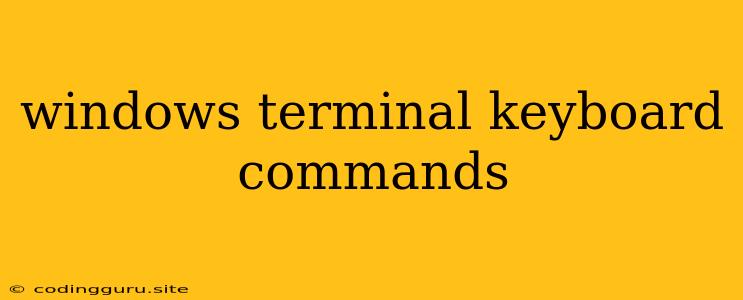Mastering Your Windows Terminal: A Guide to Keyboard Commands
The Windows Terminal is a powerful and versatile tool for navigating your system and managing your applications. But did you know that you can unleash even more power by utilizing the keyboard shortcuts it offers? By mastering these commands, you can streamline your workflow and significantly boost your productivity.
Let's dive into some of the essential Windows Terminal keyboard commands that can make your daily interactions with the terminal a breeze.
Navigating the Terminal with Ease
1. Moving Around:
- Up Arrow (↑): Recall the previous command, perfect for revisiting commands or editing them.
- Down Arrow (↓): Move down through the command history.
- Ctrl + A: Move the cursor to the beginning of the line, useful for quickly making changes at the start of a command.
- Ctrl + E: Move the cursor to the end of the line, ideal for appending text or executing a command.
- Home: Jump to the start of the current line.
- End: Jump to the end of the current line.
2. Editing Text:
- Backspace: Delete the character to the left of the cursor.
- Delete: Delete the character to the right of the cursor.
- Ctrl + Backspace: Delete the word to the left of the cursor.
- Ctrl + Delete: Delete the word to the right of the cursor.
- Ctrl + W: Delete the word to the left of the cursor, but faster!
- Ctrl + U: Delete everything to the left of the cursor.
- Ctrl + K: Delete everything to the right of the cursor.
3. Other Useful Shortcuts:
- Ctrl + C: Stop the current command or interrupt a running process.
- Ctrl + D: Close the current tab or window.
- Ctrl + L: Clear the terminal screen.
- Ctrl + R: Search your command history, extremely useful for finding previously executed commands.
- Tab: Auto-complete commands or file names, saving you time and effort.
- Ctrl + Shift + T: Reopen the last closed tab, useful for quickly navigating between open terminals.
- Ctrl + T: Create a new tab.
- Ctrl + Shift + N: Create a new window.
- Ctrl + Shift + V: Paste text in a way that preserves the original formatting, essential for commands with special characters.
Advanced Keyboard Commands
1. The Power of Ctrl + Shift:
- Ctrl + Shift + T: This powerful shortcut lets you reopen the last closed tab in the terminal. It's a lifesaver if you accidentally close a tab and need to access its content again.
2. Customizing Your Workflow:
- Ctrl + Shift + P: Open the command palette, allowing you to access a wide range of settings and features.
- Ctrl + Shift + N: Create a new terminal window, useful for running multiple commands simultaneously or working on different projects.
3. Working with Profiles:
- Ctrl + Shift + +: Switch to the next profile.
- Ctrl + Shift + -: Switch to the previous profile.
4. Enhanced Navigation:
- Ctrl + Page Up: Navigate to the previous tab in the terminal.
- Ctrl + Page Down: Navigate to the next tab in the terminal.
Mastering the Windows Terminal Keyboard Commands:
- Practice: Make a conscious effort to use these keyboard shortcuts regularly. The more you use them, the more natural they will become.
- Explore: Experiment with different combinations and discover shortcuts that are most useful for your workflow.
- Customize: The Windows Terminal offers extensive customization options. Utilize these options to set up your terminal environment in a way that maximizes your productivity.
Conclusion
By incorporating these Windows Terminal keyboard commands into your workflow, you can significantly streamline your daily interactions with the terminal. These shortcuts empower you to navigate, edit, and manage your terminal environment with greater efficiency, leading to a more productive and enjoyable experience.
